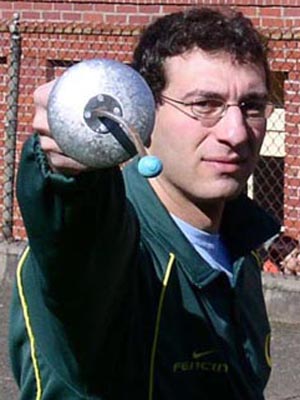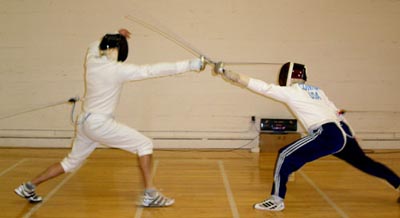
Sports
- The Outdoor Program helps people plan adventures.
- Adam Lake uses fencing to bring people together.
- Win or lose, the Pit Crew keeps Mac Court shaking for the Ducks.
- Tearing at jerseys and slamming into each other. It's women's rugby.
Changes
- A Taiwanese student finds adjusting to a foreign culture challenging.
- A close-up look at the ASUO president.
- A senior's abrupt transition to Eugene after Hurricane Katrina.
Arts
- A ballroom dance club president wears many hats and makes them too.
- Whether composing or jamming on his mandolin, Jesse Jones shares his love of music.
- Non-traditional African dance brings a new sense of community.
- The Student Fibers Guild proves that knitting isn't just for old ladies anymore.
- Halo Jones' music and art expresses his dark and light sides.
- A musician, student, activist and artist.
- For Ashley Maury, jewelry is more than decorative.
- A student TV show features news, sports, drama and comedy.
- A printmaking student goes beyond the studio and into the city.

Adam Lake uses fencing to bring people together at U of O.
By Samantha Bates
Wearing white knickers, a square jacket, and a dark, netted mask, University of Oregon fencing club coach Adam Lake instructs the new fencer on technique. His pupil, a novice, wears jeans and a borrowed jacket and mask from the club’s equipment room.
Lake, 26, a graduate student in U of O’s Geography Department, is the volunteer coach of the fencing club.
“Keep your tip up and in line with your hand,” Lake says as he grabs the foil’s tip and straightens the novice’s arm. He takes the tip in his hand, lines it up with his own chest to show the fencer where to aim. “You want to know exactly where your tip is going to be,” Lake says.
Lake lets the fencer step back, then he takes him through the basic motions.
“Stab,” Lake says.
The fencer extends his hand and straightens the foil.
"Advance,” Lake instructs.
The fencer steps forward on a straight line. He moves only his front leg, bending it to a 90-degree angle. His back leg remains stationary, extended and straight.
“Good,” Lake commends him. “Now make sure you’re stepping on the heel. Make sure you get your foot far enough out that you can bend your knee over it.”
He reaches out and touches the fencer on the shoulder. “Relax your shoulder,” he says.
He lets the fencer step back again and tells him to repeat the steps over and over several times: “Stab, advance, good.”
Lake takes his time with the novice. He walks him through the basics step by step and teaches him on an individual basis. His teaching technique is very one-on-one. Lake knows that fencing is a close, personal sport and must be taught on an individual basis with care and precision.
But despite the time and consideration he takes with each club member, he is modest about his role.

U of O Fencing Club Coach Adam Lake |
“I don’t consider myself a good coach,” he said. He took over the club in 2002, after the former coach graduated. He volunteers his time to coach two days a week for two hours each session and takes the club members to tournaments. “Sometimes there’s no one else to do the job, so you fall into it,” he said. “I do what I can.”
Joe Leary, club coordinator and fellow fencer, disagrees. “His teaching has basically made me a better fencer,” he said. Leary said Lake’s coaching is one of the reasons he was able to attain the American Fencing Association’s highest competitive rating. “He knows how to explain things,” Leary said. “He emphasizes the core elements.”
Lake also emphasizes the mental aspects of the sport. “He doesn’t teach a style,” Leary said. “He teaches core values, not how you hit. He teaches decision making instead of going through the motions.”
And, Leary said, Lake treats the sport with respect.
“He brings some level of maturity to the sport,” Leary said. “It’s not just fighting with sticks.”
Lake said he tries to emphasize the athletic aspect of the sport. He tries to draw in athletes, rather than people who just want to fight with sticks. “They don’t realize it’s athletic,” he said. “You have to be in good shape. You’re moving all the time. You have to have the energy to go.”
When Lake himself fences, it’s all energy. He stays light on the balls of his feet, ready to react to his partner’s movements. He darts forward. He stretches his entire 6-foot-3-inch height into the lunge. His foil thrusts sharply forward, penetrating his partner’s defenses. The foil bends into a fine arc when it makes contact with his partner’s shoulder. Lake scores a touch.
Lake’s defense is just as sharp. He parries his partners’ blade with quick, exact movements. His blade twists in the smallest jerk. It flips up into a vertical position, deflecting his partners’ foil. His partner’s blade slides past Lake as the fencer’s momentum sends him charging past Lake. No touch is scored.

At practice, Lake parries Josh Conner's attack. |
“Adam uses a blade-intense style,” said Josh Conner, a fellow fencer and Lake’s roommate. They met three years ago when Conner joined the fencing club. “He fences the opposite game as me,” Conner said. “I don’t use the blade for defense, I just retreat.” Conner prefers to use his feet to evade attacks. He said Lake uses his blade to deflect the attack, and therefore doesn’t have to move as quickly. Lake holds his ground.
“His style is practical,” said Leary. Leary said Lake combines blade work, distance and timing. “He brings it all in and mixes it together for a sort of hybrid style.”
Lake's individual style has evolved over the dozen years he's spent fencing.
Lake began fencing at the age of 14 in his home town of Cleveland. He continued to fence through high school and later fenced on the varsity team while attending Lawrence University in Wisconsin. Lake said the team competed in tournaments every weekend during the regular season, from December to April.
After graduating with a degree in environmental science, he moved to Eugene in 2002. He fenced at the Eugene Fencing Club while working as a research assistant before he returned to school and took over U of O’s fencing club.

Next Page